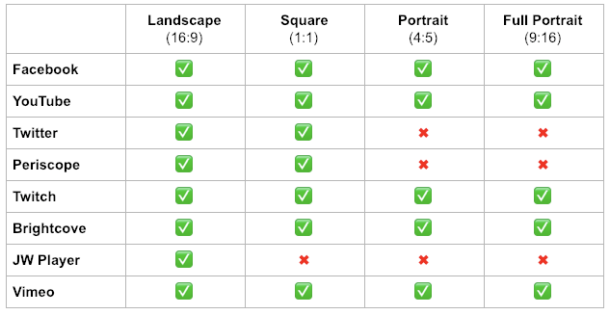Let’s face it: we don’t like to turn our phones into horizontal, TV screens.
Thanks to popular apps like Snapchat and Instagram, vertical video made its way to the limelight in 2012. But for video creators, producing high quality, sophisticated video for mobile audiences hasn’t always been as easy as it seems.
Rather than relying on your smartphone to capture vertical video, we are excited to share you can now elevate the look and feel of your videos straight from your desktop using Socialive.
We dive into what vertical video is and why brands can’t afford to ignore the trend any longer.
WHAT IS VERTICAL VIDEO?
Vertical video, also known as vertically-oriented or portrait-mode video, is one that is taller than wider. Full portrait video uses a 9:16 aspect ratio and is formatted to take over the full vertical screen on a smartphone.
So, which platforms support vertical video? Here’s a handy chart that breaks down each platform and its aspect ratios:
THE BENEFITS OF VERTICAL VIDEO
Below, we rounded up a few key statistics that show why vertical video is the dominant format to pay attention to.
1. MOBILE VIDEO CONSUMPTION CONTINUES TO INCREASE
There’s no doubt video is a powerful medium.
Combine that with stay-at-home orders during a pandemic and the rise of addictive mobile apps like TikTok, more businesses are turning to video marketing to reach their mobile audiences.
In fact, U.S. adults spend 13 minutes daily accessing video apps alone on a smartphone, according to Statista. Not to mention, mobile video ad spend has overtaken desktop video ad spend, and is projected to exceed 8.6 billion U.S. dollars in 2023.
2. SQUARE VIDEO TAKES UP MORE REAL ESTATE
In a world where everyone is trying to catch their audience’s attention, how do you create eye-catching video? By taking up space.
Square video (1:1) takes up 78% more real estate in a user’s mobile newsfeed than landscape video (16:9), according to Buffer. Square video can expand to fit the height ratio and is 1280px x 1280px.
That explains why square video is the recommended go-to format for social media channels like Facebook, Instagram, and Twitter.
3. VIDEO FORMAT IMPACTS ENGAGEMENT
If you didn’t think that video format impacts engagement, think again.
Square videos result in better video views, engagement (likes, comments, and shares) and completion rates than landscape video on social media, according to the same Buffer report.
In some cases, square videos resulted in up to 35% higher video views and an 80 to 100% increase in engagement.
The overall takeaway? Regardless of content, the format of your video is a determining factor in how long viewers watch your video, and if they engage with it.


